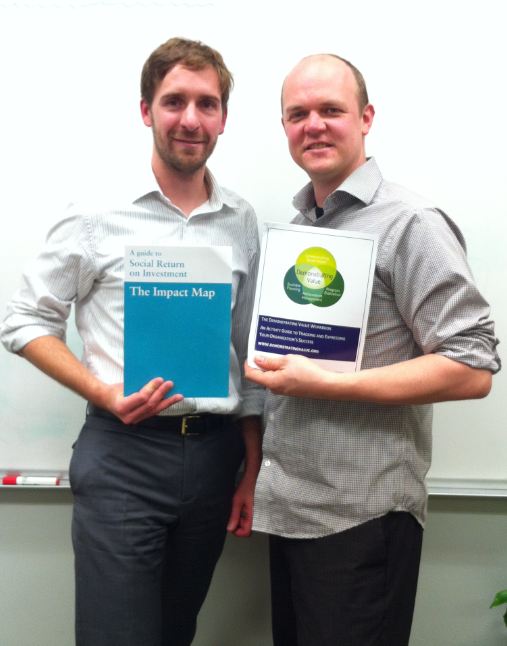There’s added value in using multiple frameworks when completing an impact evaluation. SROI – an evaluation framework growing in popularity – expresses value in monetized terms, and is one such framework that can be used in conjunction with Demonstrating Value.
We sat down with Simon Anderson  (left), senior SROI analyst with Social Asset Measurements and Garth Yule (right), manager of evaluation and community impact with Vancity Community Foundation to find out how Demonstrating Value and SROI can work together to provide a deeper understanding of social impact.
(left), senior SROI analyst with Social Asset Measurements and Garth Yule (right), manager of evaluation and community impact with Vancity Community Foundation to find out how Demonstrating Value and SROI can work together to provide a deeper understanding of social impact.
What’s the value of using Demonstrating Value or SROI? Is there added value in using both frameworks together?
SA: The value of using SROI is that it provides a set framework for measuring the social impact of an organization. The processes involved, and the end result, enables organizations to demonstrate, in monetized terms, the value created by the organization. As a result, a benefit-cost ratio can be calculated which can be used for internal management and external reporting purposes.
As for the value of using SROI in conjunction with DV, SROI focuses on the individual level, meaning that the analysis concentrates on how a program influences the outcomes for program participants. Therefore, SROI can be used alongside DV, as SROI can isolate the impact of the program and DV can be used to assess the organizational outcomes. In fact, combining the two will lead to a more fulsome and detailed analysis than using them independently from each other.
GY: It’s also important to recognize that DV and SROI are quite similar in the first phase of aligning indicators and data collection with the mission and goals of the organization. The choice of one framework or the other for the analysis and reporting phase should be made with the audience in mind. SROI may suit funders’ desire to know about the economic efficiency of their grants, whereas DV may suit investors’ and management’s desire for data to guide a strategic plan for achieving scale. Social enterprises often need to address both, and combining the frameworks saves duplicating the work in the first phase.
How do you choose the right indicators? Can the same indicators be used for both DV and SROI assessments?
GY: Indicators should provide information more beneficial than the cost of collecting it – DV recommends prioritizing indicators on a cost/benefit scale. DV offers more flexibility in including qualitative information and data about outcomes that are not easily monetized. Both frameworks aspire to be tools to improve management capacity; DV may offer more leeway to customize the indicators to address business planning and strategic questions.
SA: For a SROI assessment, choosing indicators involves a number of steps. First of all, it is important to determine the key stakeholders associated with the program that is being assessed. Once this is complete, it is necessary to consult with the stakeholders to gain their insight and understand how the program influences their lives. Once the outcomes are identified, indicators that are measurable and directly linked to the outcomes should be chosen.
Some of the indicators chosen for a SROI assessment can be used for a DV assessment. However, it should be noted that a SROI assessment emphasizes the use of indicators that can be monetized.
How can DV contribute to effective communication of an SROI analysis?
SA: The DV dashboard would be a useful tool for communicating the results of a SROI analysis. While the SROI process involves gathering and utilizing a significant amount of data, other than the SROI ratio, there is not a standardized way of communicating the results. Thus, the DV dashboard could fill this gap.
GY: DV also has a strong element of story telling to it – while developing a snapshot can benefit from using standard metrics libraries like IRIS, the workbook encourages users to design their snapshots in a way that captures the essence and spirit of their work in a way that can inspire and surprise the reader. This focus on narrative and reader engagement can add vibrancy and context to the technical depth of impact analysis that comes from SROI.
For organizations looking to complete a SROI assessment or work through the DV process, what are the first steps they should take?
GY: Assessing your own capacity to take on the work is very important. It is better to develop a manageable system for tracking three key indicators on an ongoing basis than to do a tremendous one-off report that doesn’t build impact evaluation into the core systems of the organization. For small organizations with limited capacity, DV offers building blocks that can be a precursor to a full fledged SROI analysis a year or two down the road.
SA: When an organization is looking at a SROI analysis, two important initial steps are to: 1) determine the organization’s theory of change; and, 2) assess the data that is already being collected by the organization.
1) In regard to determining the theory of change, this involves identifying: the key activities of the program, the stakeholders, and how the activities impact the stakeholders. This step ensures there is a clear vision regarding the outcomes of the program, which enables the development of strong indicators for the SROI assessment.
2) With respect to assessing the data that is already being collected, this is important because a SROI assessment requires detailed data, and if this is not being collected, planning is needed to implement the necessary data collection strategies.
SROI and Demonstrating Value: How can both frameworks provide a deeper understanding of social impact?
blog type:
Issues & Ideas
Tools
